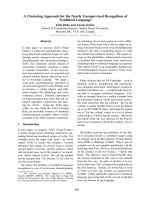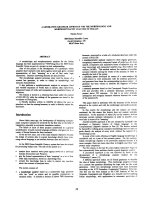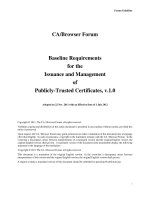A multiscale modeling approach for the progressive failure analysis of textile composites
Bạn đang xem bản rút gọn của tài liệu. Xem và tải ngay bản đầy đủ của tài liệu tại đây (12.84 MB, 282 trang )
A MULTISCALE MODELING APPROACH FOR THE
PROGRESSIVE FAILURE ANALYSIS OF TEXTILE
COMPOSITES
MAO JIAZHEN
NATIONAL UNIVERSITY OF SINGAPORE
2014
A MULTISCALE MODELING APPROACH FOR THE
PROGRESSIVE FAILURE ANALYSIS OF TEXTILE
COMPOSITES
MAO JIA ZHEN
(B.Eng. (Hons)), NUS
A THESIS SUBMITTED
FOR THE DEGREE OF DOCTOR OF PHILOSOPHY
DEPARTMENT OF MECHANICAL ENGINEERING
NATIONAL UNIVERSITY OF SINGAPORE
2014
DECLARATION
I hereby declare that the thesis is my original work and it has been written by me in
its entirety.
I have duly acknowledged all the sources of information which have been used in
the thesis.
This thesis has also not been submitted for any degree in any university previously.
Mao Jia Zhen
22 Mar 2014
Acknowledgement
i
Acknowledgement
This thesis is submitted in fulfilment of the requirement for award of the degree of
Doctorate of Philosophy. The research has been carried out at the Department of
Mechancial Engineering, National University of Singapore, during the period of Augest
2009 to July 2013.
I am deeply indebted to Professor Tay Tong Earn for giving me the opportunity and
supervising this work. Especially during the most challenging period of finalising my
thesis, without his all-around support and guidance, this work would have never been
accomplished.
I would also like to thank A/Prof. Vincent Tan Beng Chye, for his invaluable help. The
numerous discussions are important to this work.
I am very grateful to Doctor Muhammad Ridha and Doctor Sun Xiu Shan for their
advices and help.
I am truly thankful to Mr. Chiam Tow Jong, Mr. Low Chee Wah and Mr. Abdul Malik
Bin Baba for assisting me in my experiments.
Lastly, I would like to deeply thank Ms. Wang Xuan, my daughter Mao Dou Dou, my
father Mao Cheng Ming and mother Yang Pei Zhi for their love, support and
encouragement throughout my life. You are the reason of this work.
Table of Contents
ii
Table of Contents
Acknowledgement i
Table of Content ii
Summary…… vi
Nonmenclature…… viii
List of Figures…… xiii
List of Tables…… xxiii
Chapter 1 Introduction and Literature Review 1
1.1 Introduction to Textile Structural Composites 3
1.2 Review of Mechanical Modeling of Textile Composites 7
1.3 Review of Damage Modeling of Textile Composites 27
1.3.1 Failure Criteria 28
1.3.2 Progressive Damage Modeling Techniques 32
1.4 Aim of the Study 40
1.5 Scope and Outline 40
Chapter 2 Multiscale Modeling Approach 42
2.1 Material Property Homogenization Method 45
2.1.1 Periodic Boundary Conditions 46
2.1.2 Effective Material Properties 49
2.1.3 PBC Modeling to a 3D RVE Model 52
2.2 Micro-Mechanical Failure (MMF) Theory 57
2.2.1 Stress Amplification Method 57
2.2.1.1 Micro Stresses Calculated from Meso Stresses 58
2.2.1.2 Meso Stresses Calculated from Macro Stresses 61
2.2.2 Fiber Failure Criterion 64
2.2.3 Matrix Failure Criterion 65
2.3 Progressive Damage Modeling 66
Table of Contents
iii
2.3.1 Energe-based Continuum Damage Mechanic Model 69
2.4 Flow Chart 73
2.5 Conclusion 76
Chapter 3 Progressive Failure Analysis of Plain Woven Composites 77
3.1 Modeling Strategy 77
3.2 Micromechanical Model 78
3.3 Mesomechanical Model 85
3.3.1 Geometric Modeling 87
3.3.2 Stress Analysis. 92
3.3.3 Progressive Failure Analysis 100
3.3.4 Validation by Experiment 105
3.4 Macromechanical Model 110
3.4.1 FE Modeling… 110
3.4.2 Simulation Result… 112
3.4.3 Validation by Experiment… 114
3.5 Conclusion 119
Chapter 4 Progressive Failure Analysis of NCF Composites 121
4.1 Introduction to NCF composites 121
4.2 Nonlinear Mechanical Modeling of NCF composites 123
4.2.1 Modeling of Elastoplasticity for Epoxy Resin 124
4.2.1.1 Elastoplastic Constitutive Model 126
4.2.1.2 Parameter Identification 129
4.2.2 Nonlinear Stress Amplification Method 131
4.2.2.1 Method to Determine Nonlinear Coefficient 134
4.2.3 Implementation of Nonlinear Multiscale Modeling 135
4.3 Micromechanical Model 136
4.4 Mesomechanical Model 145
4.4.1 Case 0 degree Laminate 146
Table of Contents
iv
4.4.2 Case Biaxial Laminates 156
4.4.2.1 Simulation Results… 162
4.4.3 Experimental Verfication 168
4.5 Macromechanical Model 173
4.5.1 Macroscopic Modeling 173
4.5.2 Simulation Results 175
4.5.3 Experimental Verification 184
4.6 Conclusion 188
Chapter 5 Extension to Mechanics of Defects in NCF Composites 189
5.1 Introduction to Defects Mechanics of Composite Materials 189
5.2 Study the Influence of Defects in NCF composites 194
5.2.1 Linear Analysis on Single Laminate 195
5.2.2 Failure Analysis on Biaxial Laminates 200
5.2.2.1 Defect Characterization 200
5.2.2.2 Case [0/90]
2s
Laminates 203
5.2.2.3 Case [±45]2s Laminates 207
5.3 Conclusion 212
Chapter 6 Conclusions and Recommendations 214
6.1 Conclusions 214
6.2 Recommendations for Future Work 217
References 220
Appendix A Plain Woven Composites Study 243
A.1 Mesh Convergency Study for Plain Woven RVE Model 243
A.2 Sensitivity Study for Plain Woven Composites 243
Table of Contents
v
Appendix B NCF Composites Study 246
B.1 Mesh Convergency Study for NCF RVE Model 246
B.2 Nonlinear COfficients for Meso-to-Micro Stress Amplification 248
B.3 Nonlinear COfficients for Macro-to-Meso Stress Amplification 251
B.4 Sensitivity Study for NCF Composites 255
Article by the author
Mao J Z, Sun X S, Ridha M, Tan V B C, and Tay T E. A modeling approach across length scales
for progressive failure analysis of woven composites. Applied Composite Materials, 20: 213-231,
2013.
.
Summary
vi
Summary
Recent advances in textile composites require the development of a holistic modeling tool,
which involves more than one length scale. Over the past decades, a large number of
modeling techniques, capable of predicting accurately the mechanical performance of
composite materials covering wider range of length scales are available. However, there
is still a strong demand for a computational approach to implement the mechanical
analysis for a macroscopic structure based on the micro-physical phenomena. With the
rapid development of computer power, it is possible to integrate the available modeling
tools into a holistic multiscale framework capable of simulating, designing and analyzing
the performance of composite materials. In this thesis, a multiscale modeling approach to
model the progressive damage in textile composites has been developed. The hierarchical
models of textile composites at three different length scales (micro, meso, and macro) are
developed with a novel two-way multiscale coupling technique. In this manner, the
multiscale stress analysis is performed and the damage mechanisms can be captured
within one finite element. Appropriate failure criteria are carefully selected in the present
study. In addition, a continuum damage mechanics (CDM) method is used to model the
post-failure behavior of the damaged element.
The proposed multiscale method is first applied to predict the material stiffness, tensile
strength and damage patterns of a central open-hole plain woven laminates. Tensile
experiment is conducted to verify the analysis result. Consequently, the progressive
Summary
vii
failure analysis based on a nonlinear multiscale modeling approach is implemented for
the non-crimp stitched textile composites considering the material nonlinearity of epoxy
resin. The global mechanical analysis of unnotched quasi-isotropic laminates has been
performed and validated by the experiment.
Finally, the proposed progressive failure analysis is extended to the defect mechanics of
non-crimp stitched composite laminates. The parametric study based on defect modeling
indicates the correlation between the void contents and mechanical properties. The
numerical analysis result is validated by the experimental data.
Nomenclature
viii
Nomenclature
E
Global strain matrix
Σ
Global stress matrix
C
Stiffness matrix
C
Effective stiffness matrix
I
Identity matrix
M
Stress amplification matrix
Subscript
,,mM
Microscale, Mesoscale and Macroscale
Subscript
1,2,3
Directions of material coordinate system where 1 refers to fiber
direction
Subscript
zyx , ,
Directions of global coordinate system
Subscript m Matrix phase
Subscript f Fiber phase
Subscript I, II, III Delamination mode I, mode II and mode III
ε
Strain vector
ε
Global strain vector
σ
Stress vector
σ
Global stress vector
x
u
,
y
u
z
u
Displacements in three coordinate directions
, , , , ,xx yy zz xy xz yz
Six components of the mechanical strain vector in global coordinates
Nomenclature
ix
11, 22, 33, 12, 13, 23
Six components of the mechanical strain vector in local material
coordinates
, , , , ,xx yy zz xy xz yz
Six components of the mechanical stress vector in global coordinates
11, 22, 33, 12, 13, 23
Six components of the mechanical stress vector in local material
coordinates
,EG
Young’s modulus and Shear modulus
00
,EG
Initial effective Young’s modulus and shear modulus
**
,EG
Residual effective Young’s modulus and shear modulus
Poisson ratio
ij
d
Material properties degradation factor
s
n
Softening factor
V
Volume domain
S
Tensile strength
S
Compressive strength
shear
S
Shear strength
vM
von Mises stress
1
I
First stress invariant
2
I
Second stress invariant
c
G
Fracture toughness
Superscript
1,2,3,4,5,6
Six boundary conditions
dummy
u
Displacement defined at the dummy point
Nomenclature
x
X+, Y+, Z+ Master surfaces on a RVE along three global coordinates
X-, Y-, Z- Slave surfaces on a RVE along three global coordinates
x
Initial distance between the opposite boundary surfaces on a RVE
w
Critical crack open width when the load falls to zero
s
F
Critical load to initiate a crack
D
MMF
Damage index from Tsai-Ha failure theory
V
f
Fiber volume fraction
Z(x) Fiber yarn crimp height
eff
Effective stress
0
y
Initial yield stress
,
p
f σ ε
Yield function
g σ
Plastic potential function
n
Gradient of the plastic potential function
H
’
Tangent modulus
Subscript e Elasticity
Subscript p Plasticity
Subscript L Local coordinate
Subscript G Global coordinate
M σ
Nonlinear stress amplification matrix
0
M
Initial stress amplification matrix
D σ
Nonlinear coefficient matrix
P
stitch
Bridging force on the stitches
Nomenclature
xi
P
a
Peak bridging force
stitch
Displacement of stitching fiber
a
Displacement of stitching fiber at peak bridging force
h Thickness of laminate
A
eff
Effective cross-section area of stitching fibers
a
Effective tensile stress on the stitching fibers at peak bridging force
n
t
Normal traction for delamination mode I
s
t
Shear traction for delamination mode II
n
t
Shear traction for delamination mode III
n
G
Energy release rate by the mode I normal traction
s
G
Energy release rate by the mode II shear traction
t
G
Energy release rate by the mode III shear traction
V
V
Void contents
UD Unidirectional
NCF Non-crimp fabric
FE Finite element
FEM Finite element method
FEA Finite element analysis
2D Two-dimensional
3D Three-dimensional
MPDM Material property degradation method
Nomenclature
xii
CDM Continuum damage model
CAI Compression after impact
MD Molecular dynamics
List of Figures
xiii
List of Figures
Figure 1.1 Basic textile architectures 1
Figure 1.2 Types of woven fabrics 4
Figure 1.3 Braid angle in biaxial braided fabric. 5
Figure 1.4 Multiaxial multiply stitched non-crimp fabrics. 6
Figure 1.5 Discretized-subcell division from representative cell. 9
Figure 1.6 3D voxel representative model for woven composite. 9
Figure 1.7a Micromechanical model proposed by Totry et al 12
Figure 1.7b Failure envelop in the multiaxial stress space 13
Figure 1.8 2D geometrical model of fiber yarns in plain woven fabric. 15
Figure 1.9 Geometrical model for plain woven composite. 16
Figure 1.10 FE modeling scheme of the effect of z-pin by distributed nonlinear springs:
(a) schematic of a DCB test; (b) section of z-pinned composite; (c) FE
model for this section with distributed springs. 18
Figure 1.11 Illustration of deviations of fiber orientations caused by stitching yarn: (a)
Cracks in 45
o
ply; (b) Channels in 90
o
ply. 20
List of Figures
xiv
Figure 1.12 Scheme of RVE model of NCF composites with different fiber
orientations: (a) 0 degree; (b) 45 degree; (c) 90 degree 21
Figure 1.13 Scheme of RVE model of NCF composites with additional stitchines: (a) 0
degree; (b) 45 degree 21
Figure 1.14 Crack modeling within the transverse fiber tow of the plain woven unit
cell 38
Figure 2.1 Multiscale damage mechanisms of textile composites. 43
Figure 2.2 Multiscale modeling strategy of textile composites 44
Figure 2.3 Periodic structure (a) undeformed shape of RVE (b) deformed shape of
RVE 46
Figure 2.4 Illustration of displacement continuity condition 47
Figure 2.5 Material property homogenization for a heterogeneous RVE 50
Figure 2.6 Three pairs of boundary surfaces of a 3D RVE model. 53
Figure 2.7 Usage of dummy points for PBC modelling 56
Figure 2.8 Microscopic RVE with (a) square fiber arrangement (b) hexagonal fiber
arrangement 60
Figure 2.9 Reference points in microscopic RVE: (a). Matrix of square model; (b).
Matrix of hexagonal model; (c). Fiber of square and hexagonal models 61
List of Figures
xv
Figure 2.10a Reference point selected in fiber yarn based on meso analysis according to
σ
11
. 63
Figure 2.10b Reference point selected in fiber yarn based on meso analysis according to
σ
11
. 63
Figure 2.11 Damage modes for textile composite 67
Figure 2.12 Constitutive behavior for the failed element 70
Figure 2.13 Flowchart of the progressive failure analysis implementation 75
Figure 3.1 Local stress contours in square microscale RVE: (a). Longitudinal axial
stress σ
11
under BC1; (b). Transverse axial stress σ
33
under BC3; (c).
Longitudinal in-plane shear stress τ
13
under BC5; (d). Transverse shear
stress τ
23
under BC6. 82
Figure 3.2 Local stress contours in hexagonal microscale RVE: (a). Longitudinal
axial stress σ
11
under BC1; (b). Transverse axial stress σ
33
under BC3; (c).
Longitudinal in-plane shear stress τ
13
under BC5; (d). Transverse shear
stress τ
23
under BC6 83
Figure 3.3 Typical stress amplification factors and the corresponding reference points
in square RVE 84
Figure 3.4 Typical stress amplification factors and the corresponding reference points
in hexagonal RVE 85
Figure 3.5 Fiber yarns in mesoscopic RVE of plain woven composites 86
List of Figures
xvi
Figure 3.6 Cross section micrograph of the plain woven composite laminate 87
Figure 3.7 Geometry of fiber yarn 88
Figure 3.8 Three-dimensional Modeling of fiber yarn in ABAQUS 90
Figure 3.9 Mesoscale finite element model: (a) Whole RVE (b) resin pocket (c) fiber
yarn 91
Figure 3.10 Local orientations prescribed in fiber yarns 92
Figure 3.11 Reference points in yarn under BC1 based on local stress σ
11
. 95
Figure 3.12 Reference points in resin pocket under BC1 based on D
MMF
. 96
Figure 3.13 Reference points in yarn under BC4 based on local stress τ
12
96
Figure 3.14 Reference points in resin pocket under BC4 based on D
MMF
. 97
Figure 3.15 Reference points in yarn under BC3 based on σ
33
97
Figure 3.16 Reference points in resin pocket under BC3 based on D
MMF
. 98
Figure 3.17 Reference points in yarn under BC5 based on τ
13
98
Figure 3.18 Reference points in resin pocket under BC5 based on D
MMF
. 99
Figure 3.19 Matrix damage initiation modes in: (a) fiber yarns (ε
xx
=0.12%); (b) resin
pocket (ε
xx
=0.15%). 102
List of Figures
xvii
Figure 3.20 Damage evolution of matrix in: (a) fiber yarns (ε
xx
=0.3%); (b) resin pocket
(ε
xx
=0.3%). 103
Figure 3.21 Damage patterns at: (a) fiber failure initiation in weft yarns (ε
xx
=1.08%);
(b) first significant load drop in resin pocket (ε
xx
=1.16%) 103
Figure 3.22 Longitudinal stress-strain relation based on meso failure analysis 105
Figure 3.23 Configuration of the VRTM system 106
Figure 3.24 Experiment setup with extensometer 107
Figure 3.25 Comparison of the stress-strain relations between simulation and
experiment 108
Figure 3.26 Failure pattern of tested unnotched specimen 109
Figure 3.27 Macroscale FE model for OHT problem 111
Figure 3.28 Progressive damage patterns predicted from macro failure analysis 113
Figure 3.29 Longitudinal stress-strain relation from Macro FE analysis with CDM
modeling 114
Figure 3.30 Untested plain woven OHT specimen 115
Figure 3.31 Comparison of results between FE simulation and Experiment 116
Figure 3.32 Tested plain woven OHT specimen 118
List of Figures
xviii
Figure 4.1 Uniaxial tensile test results for (a) [0/90]
ns
NCF laminates; (b) and (c) [
45]
ns
NCF laminates. 125
Figure 4.2 Tensile test samples for pure epoxy resin 130
Figure 4.3 Tensile Test results for pure epoxy resin samples. 131
Figure 4.4 Three-dimensional hexagonal microscale RVE model 137
Figure 4.5 Stress-strain curve of micromechanical analysis under longitudinal tension.
138
Figure 4.6 Stress-strain curve of micromechanical analysis under transverse
tension… 138
Figure 4.7 Stress-strain curve of micromechanical analysis under longitudinal
shear… 139
Figure 4.8 Stress-strain curve of micromechanical analysis under transverse
shear…… 139
Figure 4.9 Floating reference point positions under transverse tension. 142
Figure 4.10 Predicted global-local stress relations from micro analysis under
transverse tension 144
Figure 4.11 Parameter identification for NCF mesoscale RVE model 147
Figure 4.12 Top view of biaxial NCF fabric 148
Figure 4.13 Import 3D mesoscale RVE geometry to 3D FE mesh. 149
List of Figures
xix
Figure 4.14 Local stress distribution in the mesoscale RVE under six periodic loading
conditions. 150
Figure 4.15 Stress-strain curve of meso analysis under six periodic loading
conditions… 152
Figure 4.16 Predicted matrix damage onsets within fiber yarns and resin rich zones
under six periodic loading conditions. 154
Figure 4.17 Layouts of biaxial NCF laminates: (a). [0/90]
2s
; (b). [
45]
2s
. 158
Figure 4.18 Fiber pull out model [43]: (a) Mode I in DCB model; (b). Mode II in 3-
point bending model. 159
Figure 4.19 Schematic of the bi-linear relationship of the fiber bridging 161
Figure 4.20 Local stress contours σ
11
of [0/90]
2s
laminates under longitudinal tension
BC1: (a). 0 ply; (b). 90 ply 164
Figure 4.21 Local tress contours σ
11
in [
45]
2s
laminates under longitudinal tension
BC1: (a). -45 ply; (b). +45 ply. 164
Figure 4.22 Predicted progressive damages in [0/90]
2s
laminates 165
Figure 4.23 Predicted progressive damages in [
45]
2s
laminates 166
Figure 4.24 Longitudinal stress-strain curves from simulation results. 168
Figure 4.25 Longitudinal stress-strain curves from simulation results. 170
List of Figures
xx
Figure 4.26 Damage patterns of tested [0/90]
2s
NCF specimens 170
Figure 4.27 Longitudinal stress-strain curves from simulation results. 171
Figure 4.28 Damage patterns of tested [
45]
2s
NCF specimens. 172
Figure 4.29 Layout of the quasi-isotropic NCF laminates. 174
Figure 4.30 Arrangement of the spring element representing the through-thickness
stitching. 174
Figure 4.31a Predicted damages from macromechanical analysis at applied strain 0.18%.
176
Figure 4.31b Predicted damages from macromechanical analysis at applied strain 0.33%.
177
Figure 4.31c Predicted damages from macromechanical analysis at applied strain 0.38%.
179
Figure 4.31d Predicted damages from macromechanical analysis at applied strain 0.65%.
181
Figure 4.31e Predicted damages from macromechanical analysis at applied strain 1.29%.
183
Figure 4.32 Predicted stress-strain relation from macromechanical analysis 184
Figure 4.33 Failure modes of tested quasi-isotropic NCF specimens: (a) Top view for
tested specimens; (b) Top view showing matrix damage; (c) Top view
showing fiber fracture; (d) Section view showing delaminations 186
List of Figures
xxi
Figure 4.34 Comparison of results between FE simulation and Experiment 187
Figure 5.1 Multiscale defects observed in NCF composites 193
Figure 5.2 Multiscale defects schematic in NCF composites. 194
Figure 5.3 Defect modeling strategy in single NCF laminate. 197
Figure 5.4 Defect modeled in the FE model. 197
Figure 5.5 Stress contours in single NCF laminate: (a). σ
11
under longitudinal tension;
(b). σ
22
under transverse tension; (a). τ
12
under in-plane shear 199
Figure 5.6 Predicted in-plane stiffness reductions with various void contents. 199
Figure 5.7 Defect modeling strategy with fixed void content. 200
Figure 5.8 Predicted in-plane stiffness reductions with fixed void contents 201
Figure 5.9a Defects observed in [0/90]
2s
laminates. 203
Figure 5.9b Defects observed in [
45]
2s
laminates. 203
Figure 5.10 Defects schematic for biaxial NCF composites: (a) defect in [0/90]
2s
laminates; (b) defect in [
45]
2s
laminates. 204
Figure 5.11 Defect modeling strategy in [0/90]
2s
NCF laminates. 205
Figure 5.12 Progressive damages in [0/90]
2s
NCF laminates. 206
List of Figures
xxii
Figure 5.13 Predicted stress-strain curve from FE simulation of [0/90]
2s
NCF
laminates 207
Figure 5.14 Defect modeling strategy in [±45]
2s
NCF laminates. 209
Figure 5.15 Progressive damages in [±45]
2s
NCF laminates at different applied strain
levels 210
Figure 5.16 Predicted stress-strain curve from FE simulation of [±45]
2s
NCF laminates.
212
Figure 5.17 Tensile modulus reduction of [±45]
2s
NCF laminates 212
Figure 5.18 Tensile strength reduction of [±45]
2s
NCF laminates. 212









